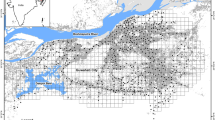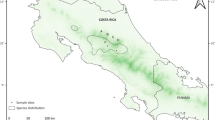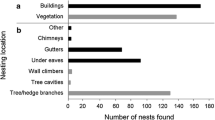Abstract
Mapping of the nests of house sparrows was carried out in 14 sampling areas in Western and Central Siberia. Quantitative assessments of nest interpositions were analyzed using the distance to the nearest neighboring nest. Cartographic visualization showed a cluster distribution of the nests. The average cluster size in different areas varied from 2.7 to 8.1 nests per cluster. No correlation was found either between their size and geographical location or their population density. No aggregations of higher rank were identified. The clusters recognized were defined as individual colonies. The distribution patterns of the frequencies of the distances to the nearest neighbor were found to be strongly exponential. Slightly more than half of all nests were located closer than 10 m to the nearest neighboring nest, and about three-quarters were located closer than 20 m. The maximum distance to the nearest neighbor inside a single colony did not exceed 80 m. No reliable indicators of isolated nesting in the house sparrow were identified. Colonies were distributed independently of one another, the distance between adjacent colonies being less where the population density was higher. Territories with closely spaced colonies could alternate with unpopulated, but suitable areas (sometimes of significant sizes).



Similar content being viewed by others
REFERENCES
Anderson, T.R., Biology of the Ubiquitous House Sparrow, Oxford: Oxford Univ. Press, 2006.
Baranovskii, A.V. and Ivanov, E.S., Gnezdyashchiesya ptitsy goroda Ryazani (Atlas rasprostraneniya i osobennosti biologii) (Breeding Birds of the City of Ryazan (Atlas of Distribution and Features of Biology)), Ryazan: Pervopechatnik, 2016.
Bell, C.P., Misapplied ecology: investigations of population decline in the house sparrow, Int. Stud. Sparrows, 2011, no. 35, pp. 24–34.
Clark, P.J. and Evans, F.C., Distance to nearest neighbour as a measure of spatial relationships in populations, Ecology, 1954, vol. 35, no. 4, pp. 445–453.
Il’enko, A.I., Ekologiya domovykh vorob’ev i ikh ektoparazitov (Ecology of House Sparrows and Their Ectoparasites), Moscow: Nauka, 1976.
Ivanitskii, V.V., Vorob’i i rodstvennye im gruppy zernoyadnykh ptits: povedenie, ekologiya, evolyutsiya (Sparrows and Related Groups of Granivorous Birds: Behavior, Ecology, Evolution), Moscow: KMK, 1997.
Kharitonov, S.P., The “nearest-neighbor” method for a mathematical assessment of the distribution of biological objects on a plane and on a line, Vestn. Nizhegorod. Univ. im. N.I. Lobachevskogo, 2005 no. 1, pp. 213–221.
Ravkin, Yu.S., On the method of counting birds of forest landscapes, in Priroda ochagov kleshchevogo entsefalita na Altae (Nature of Foci of Tick-Borne Encephalitis in Altai), Novosibirsk: Nauka. Sib. Otd., 1967, pp. 66–75.
Salek, M., Riegert, J., and Grill, S., The House Sparrows Passer domesticus and Tree Sparrows Passer montanus: fine-scale distribution, population densities, and habitat selection in a Central European city, Acta Ornithol., 2015, vol. 50, no. 2, pp. 221–232.
Sappington, J.N., Breeding biology of House Sparrows in North Mississippi, Wilson Bull., 1977, vol. 89, no. 2, pp. 300–309.
Shaw, L.M., Chamberlain, D., Conway, G., and Toms, M., Spatial Distribution and Habitat Preferences of the House Sparrow Passer domesticus in Urbanised Landscapes, BTO Research Report no. 599, 2011.
Summers-Smith, D., Colonial behavior in the house sparrow, British Birds, 1954, vol. XLVII, no. 8, pp. 249–265.
Tsybulin, S.M., Ptitsy diffuznogo goroda na primere novosibirskogo Akademgorodka (Birds of a Diffuse City on the Example of the Novosibirsk Akademgorodok), Novosibirsk: Nauka, 1985.
Vaclav, R. and Hoi, H., Importance of colony size and breeding synchrony on behaviour, reproductive success and paternity in house sparrows Passer domesticus, Folia Zool., 2002, vol. 51, no. 1, pp. 35–48.
Vartapetov, L.G., Blinov, V.N., and Zhukov, V.S., Spatiotemporal dynamics of the summer bird population of the Novosibirsk Akademgorodok and its forest–park zone, in Fauna, taksonomiya, ekologiya mlekopitayushchikh i ptits (Fauna, Taxonomy, and Ecology of Mammals and Birds), Novosibirsk: Nauka, 1987, pp. 141–170.
Yudkin, V.A., Ekologicheskie aspekty geografii ptits Severnoi Evrazii (Ecological Aspects of the Geography of Birds in Northern Eurasia), Novosibirsk: Nauka, 2009.
Author information
Authors and Affiliations
Corresponding author
Ethics declarations
The authors declare that they have no conflict of interest. This article does not contain any studies involving animals or human participants performed by any of the authors.
Additional information
Translated by L. Solovyova
Rights and permissions
About this article
Cite this article
Yudkin, V.A., Frolov, I.G. & Sleptsova, E.S. Spatial Distribution of House Sparrow Nests (Passer domesticus, Passeriformes, Passeridae) in Western and Central Siberia. Biol Bull Russ Acad Sci 48, 1084–1093 (2021). https://doi.org/10.1134/S1062359021070311
Received:
Revised:
Accepted:
Published:
Issue Date:
DOI: https://doi.org/10.1134/S1062359021070311




